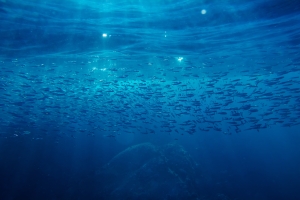This paper authored by Dr Brett Glencross was first published in the June 2025 edition of International Aquafeed
 The world's oceans are a vital source of food, supporting the livelihoods of millions of people globally. Fish provide a crucial source of protein and essential nutrients, contributing to food security, particularly in coastal communities. However, the unchecked exploitation of these resources may lead to a global crisis: some fish populations are dwindling at an alarming rate. According to the FAO 78% of the global catch is from stocks fished sustainably. As the FAO notes, “the tide is turning”, and the importance of effective fisheries management in ensuring the long-term health of fish populations and the sustainability of the fishing industry cannot be overstated. We have growing evidence that when effective fisheries management systems are used, then we can maintain and even rebuild fish stocks.
The world's oceans are a vital source of food, supporting the livelihoods of millions of people globally. Fish provide a crucial source of protein and essential nutrients, contributing to food security, particularly in coastal communities. However, the unchecked exploitation of these resources may lead to a global crisis: some fish populations are dwindling at an alarming rate. According to the FAO 78% of the global catch is from stocks fished sustainably. As the FAO notes, “the tide is turning”, and the importance of effective fisheries management in ensuring the long-term health of fish populations and the sustainability of the fishing industry cannot be overstated. We have growing evidence that when effective fisheries management systems are used, then we can maintain and even rebuild fish stocks.
Overfishing of some stocks, driven by increasing global demand, technological advancements in fishing gear, and illegal, unreported, and unregulated (IUU) fishing, has been a key driver of declining fish stocks. When fish are caught faster than the rate at which a population can reproduce, then populations decline, disrupting the delicate balance of marine ecosystems. This can have cascading effects, impacting other species that rely on those fish for food, as well as the habitats themselves. For example, the collapse of cod stocks in the Northwest Atlantic in the early 1990s had devastating consequences for the ecosystem and the livelihoods of fishing communities.
However, the consequences of overfishing extend beyond ecological damage. The livelihoods of millions of people, particularly in developing countries, depend on healthy fish populations. Small-scale fishers, who often rely on traditional fishing methods, are particularly vulnerable to the impacts of overfishing. Declining fish stocks can lead to economic hardship, food insecurity, and social instability. Therefore, effective fisheries management is essential to avoid or even reverse these trends and ensure the long-term sustainability of fish populations. It involves a science-based approach to regulating fishing activities, taking into account the biological characteristics of different species, their role in the ecosystem, and the socio-economic needs of those who depend on them.
One of the key tools of fisheries management is the setting of catch limits, or quotas. These limits are based on scientific assessments of fish stocks, considering factors such as population size, reproductive rates, and mortality rates. Such catch limits aim to ensure that fishing pressure does not exceed the capacity of the fish population to replenish itself. However, effective fisheries management requires more than just regulations. It also requires strong enforcement to ensure that regulations are being followed. This can be challenging, particularly in remote areas or on the high seas. International cooperation is essential to combat IUU fishing to ensure that all countries are playing their part in managing fish stocks sustainably.
Furthermore, successful fisheries management requires the active participation of all stakeholders, including fishers, scientists, policymakers, and local communities. Fishers, who have a direct stake in the health of fish populations, can provide valuable knowledge and insights. Collaborative management approaches, where fishers are involved in the decision-making process, can lead to more effective and sustainable outcomes. Clearly the challenges of fisheries management are complex and multifaceted. Climate change, pollution, and habitat destruction all pose significant threats to fish populations and the ecosystems they inhabit. Addressing these challenges will require a holistic approach that integrates fisheries management with broader environmental policies.
Despite the various challenges, there are many examples of successful fisheries management around the world. In some areas, fish stocks have been successfully rebuilt through a combination of science-based management, strong enforcement, and stakeholder participation. These success stories demonstrate that sustainable fisheries management is possible. One of the best examples is the Peruvian anchoveta fishery, which almost collapsed in the 1970’s but is now an exemplar of world’s best management. A great example not just because of its recovery, and adoption of science-based approach to management, with active participation of all stakeholders in its governance. But also because of its sheer scale and contribution to global food supplies both directly and indirectly, it remains today the world's largest single-species fishery.
As can be seen, effective fisheries management is essential for maintaining sustainable fish populations and ensuring the long-term health of our oceans systems. It requires a science-based approach, strong enforcement, and the active participation of all stakeholders. While the challenges are significant, the rewards of sustainable fisheries management are huge: healthy ecosystems, thriving economies, and food security for generations to come. It is our collective responsibility to ensure that fish populations are managed sustainably, so that these vital resources can continue to provide for us and for future generations.








